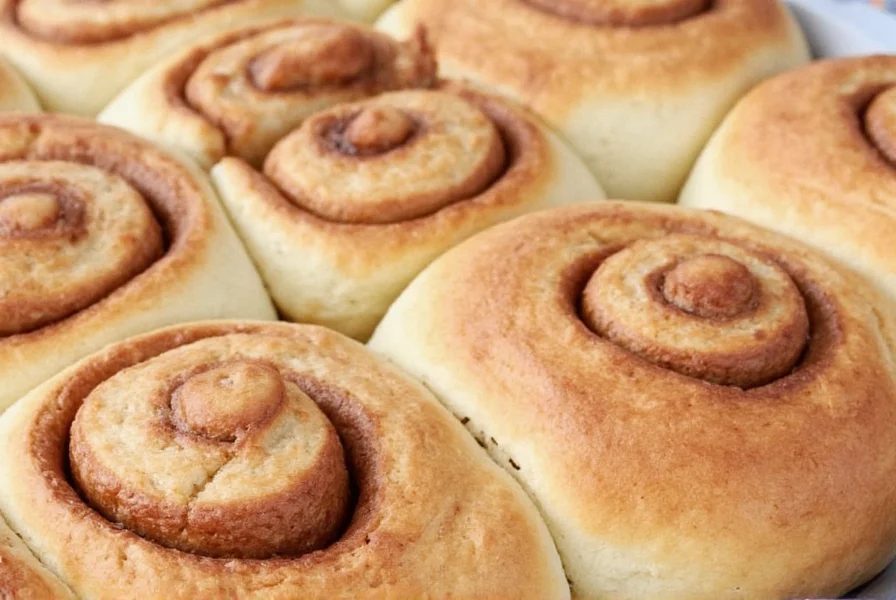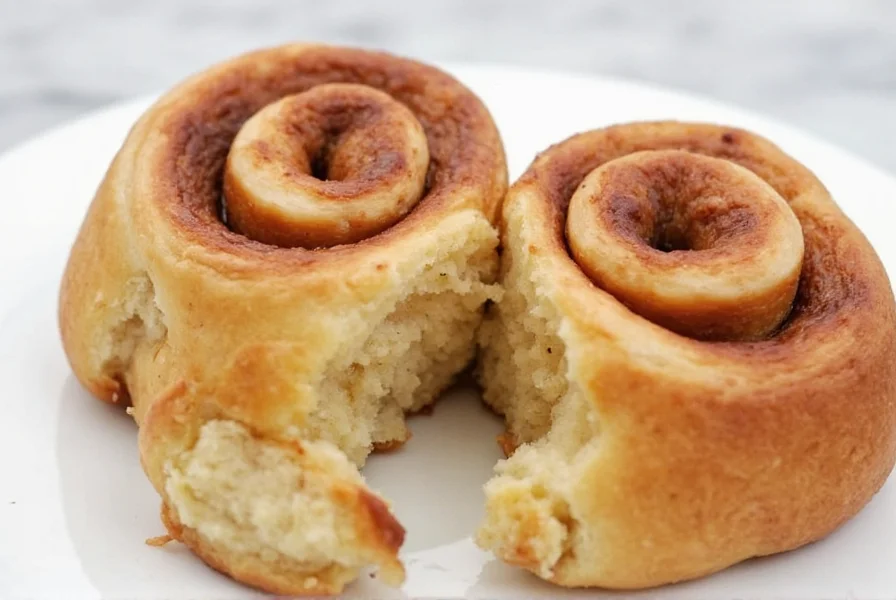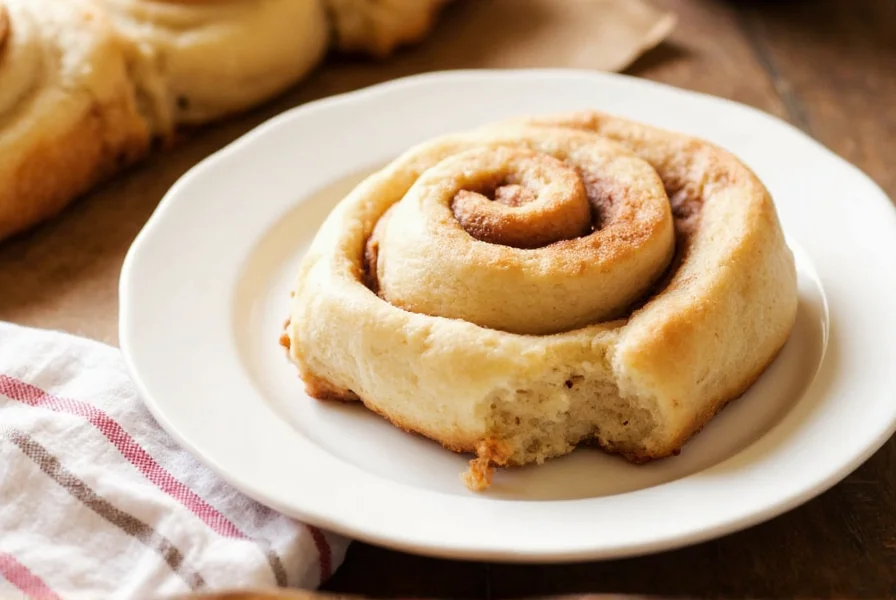The Science Behind Yeast-Free Cinnamon Rolls
Traditional cinnamon rolls rely on yeast for that signature airy texture, but yeast requires time, precise temperature control, and often isn't pantry-stocked. The yeast-free alternative uses chemical leaveners—baking powder and baking soda—to create lift through an immediate acid-base reaction. When combined with buttermilk (the acid), baking soda produces carbon dioxide bubbles that expand in the oven, giving your rolls that desirable rise without waiting hours for dough to proof.
Professional bakers know that the magic ratio is 1 teaspoon baking powder to 1/4 teaspoon baking soda per cup of flour. This balance prevents bitterness while ensuring sufficient lift. Unlike yeast doughs that develop gluten over time, this quick bread-style dough works best when handled minimally—overmixing leads to tough rolls.
Why Choose a Yeast-Free Cinnamon Roll Recipe
There are several compelling reasons to master this easy cinnamon roll recipe without yeast:
- Time efficiency: Skip the 2+ hours of rising time required for traditional recipes
- Pantry flexibility: Use ingredients you likely already have on hand
- Consistent results: No failed rises due to inactive yeast or temperature issues
- Dietary accommodation: Works for those avoiding yeast for digestive reasons
Many home bakers discover that these quick yeast free cinnamon rolls actually produce a more reliably tender texture than their yeast-dependent counterparts, especially for novice bakers.

Perfect Yeast-Free Cinnamon Roll Recipe
This tested recipe yields 12 perfectly portioned rolls with a melt-in-your-mouth texture. The secret lies in the buttermilk-baking soda reaction and proper dough handling.
| Yield | Prep Time | Cook Time | Total Time |
|---|---|---|---|
| 12 rolls | 25 minutes | 22-25 minutes | 50 minutes |
Ingredients
Dough
- 3 cups (360g) all-purpose flour
- 1/4 cup (50g) granulated sugar
- 1 tbsp baking powder
- 1/4 tsp baking soda
- 1/2 tsp salt
- 1/2 cup (113g) cold unsalted butter, cubed
- 1 cup (240ml) cold buttermilk
- 1 large egg
Filling
- 1/2 cup (113g) unsalted butter, softened
- 3/4 cup (150g) packed brown sugar
- 2 tbsp ground cinnamon
- 1/4 tsp salt
Frosting
- 4 oz (113g) cream cheese, softened
- 1/4 cup (57g) unsalted butter, softened
- 1 cup (120g) powdered sugar
- 1/2 tsp vanilla extract
- 1-2 tbsp milk
Step-by-Step Instructions
- Prepare dry ingredients: In a large bowl, whisk together flour, sugar, baking powder, baking soda, and salt.
- Cut in butter: Using a pastry cutter or fingers, work cold butter into flour until mixture resembles coarse crumbs with pea-sized pieces.
- Mix wet ingredients: In separate bowl, whisk buttermilk and egg. Pour into flour mixture and stir with fork until just combined (do not overmix).
- Form dough: Turn onto floured surface and gently knead 3-4 times until dough comes together. Pat into 12x9 inch rectangle.
- Prepare filling: Spread softened butter over dough, then sprinkle evenly with brown sugar, cinnamon, and salt.
- Roll and slice: Starting from long side, roll tightly into log. Cut into 12 equal slices using dental floss for clean cuts.
- Bake: Place rolls in greased 9x13 inch pan. Bake at 375°F (190°C) for 22-25 minutes until golden brown.
- Make frosting: Beat cream cheese, butter, powdered sugar, and vanilla until smooth. Add milk as needed for spreading consistency.
- Finish: Cool rolls 10 minutes, then spread with frosting.
Troubleshooting Your Yeast-Free Cinnamon Rolls
Even with this no yeast cinnamon roll dough recipe, issues can arise. Here's how to fix common problems:
- Dense texture: Usually caused by overmixing or expired leaveners. Measure baking powder/soda carefully and mix dough just until combined.
- Rolls spreading too much: Ensure butter in dough is cold and don't overfill with filling. Chill cut rolls 10 minutes before baking.
- Filling leakage: Don't overfill and ensure a small border of plain dough at the edge when rolling.
- Dry rolls: Overbaking is the culprit. Remove when center rolls spring back lightly when touched.
Variations for Special Diets
This cinnamon roll recipe with baking soda adapts beautifully to dietary needs:
- Gluten-free: Substitute 1:1 gluten-free flour blend and add 1 tsp xanthan gum
- Vegan: Use plant-based butter, coconut milk instead of buttermilk, and flax egg
- Lower sugar: Reduce filling sugar by 25% and use sugar-free frosting alternatives
- Flavor twists: Add orange zest to dough or swap cinnamon for pumpkin spice

Storage and Reheating Tips
These fast cinnamon rolls without rising time maintain quality when stored properly:
- Room temperature: Keep in airtight container for up to 2 days
- Refrigerator: Store for up to 5 days (reheat before serving)
- Freezer: Wrap individual rolls in plastic, then foil; freeze up to 3 months
- Reheating: Microwave 15-20 seconds or warm in 300°F oven for 5 minutes
For best results when reheating, add a small pat of butter on top before warming to restore moisture.
Frequently Asked Questions
Can I make cinnamon rolls without yeast that are as fluffy as traditional ones?
Yes, when using the proper ratio of baking powder to baking soda (1:4) with cold buttermilk, you can achieve remarkably fluffy texture. The key is not overmixing the dough and using fresh leaveners. These yeast-free rolls have a slightly different crumb structure—more like a cross between a biscuit and traditional cinnamon roll—but most tasters can't distinguish them from yeast versions when properly executed.
Why does this recipe use both baking powder and baking soda?
Baking powder provides most of the lift (it contains its own acid), while baking soda reacts with the buttermilk's acidity for additional rise and better browning. Using both creates optimal texture—baking soda alone would leave a metallic taste, while baking powder alone wouldn't provide enough lift for the rich filling. This combination mimics yeast's slow rise with an immediate chemical reaction.
Can I prepare yeast-free cinnamon rolls ahead of time?
Absolutely. You can prepare the cut rolls, place them in the baking dish, cover tightly, and refrigerate overnight. When ready to bake, let them sit at room temperature for 20 minutes while the oven preheats, then bake as directed (may need 2-3 extra minutes). The cold temperature actually improves flavor development while the baking powder remains effective for morning baking.
What's the biggest mistake people make with yeast-free cinnamon roll recipes?
Overmixing the dough is the most common error. Unlike yeast doughs that benefit from gluten development, this quick bread-style dough becomes tough when overworked. Mix wet and dry ingredients just until combined—visible streaks of flour are acceptable. Also, many home bakers use expired baking powder/soda; test your leaveners by adding a pinch to hot water—they should bubble vigorously.











 浙公网安备
33010002000092号
浙公网安备
33010002000092号 浙B2-20120091-4
浙B2-20120091-4